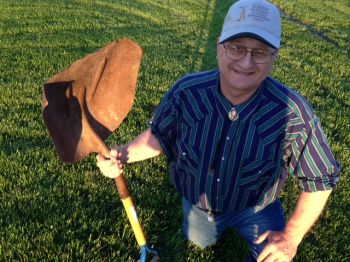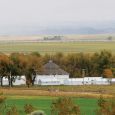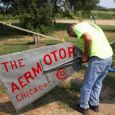The Gift of South Dakota
Subscriptions to South Dakota Magazine make great gifts!
Subscribe today — 1 year (6 issues) is just $29!
The Rusty Shovel
May 21, 2015
Editor’s Note: The indefatigable Frank Kloucek, a longtime Scotland farmer, state lawmaker and champion of rural life, reflects on the legacy of a simple farm tool that has passed through many hands.
Last fall a decision had to be made concerning an old rusty brown iron scoop shovel. Should a new handle be put on the shovel or should it go to the recyclers? As one pondered what to do, a reflection on the shovel's history came to mind. The shovel was new sometime in the 1950s so Grandpa Frank used it. Bob and Clem Kloucek, Carol, Ann, Darla, Frank, Joanie, Richard and Allen all had the opportunity to enjoy its sturdy construction, strength and reliability that did not give, crack or wear out like modern aluminum shovels. And oh did it seem heavy for a shovel at the time! As cement feed bunks and hog barns, wooden feed bunks and chicken barns were cleaned out one by one it seemed to be the shovel chosen last to be used. The aluminum ones needed repair and seemed to wear out very fast compared to the old shovel. All shovels were usually washed after their use to prevent the strong acid in the manure from eating the metal and aluminum and to prevent contamination.
Notable people who also used the old brown shovel included Jarvis Winckler, Jim Ded, Allen Crane, LaVerne Dangel, Bob Green, Rick Van Winkle, Kevin and Mike Van Winkle, Larry Chester, Eugene Peska, Greg Faller, Roman Steffen, Ron Hamberger, Roger Berndt, Dan Haase and others. Saturday mornings were “clean the hog barns" mornings. After shoveling bunks for cattle we started on the hog barns. The old shovel stood the test, time and time again.
Often we had a mid-morning “coffee break" which consisted of poppy seed coffee cake, kolaches, kuchen, caramel rolls or another great pastry, served with coffee and hot chocolate in the winter and with ice tea and cold milk served in the summer. These were made by my mother Rose or Aunt Mary Ann and really hit the spot!
After the break it was back to the grind, shoveling the manure into the loader bucket of the F-11 Farmall loader mounted on an IHC 560 diesel tractor. We loaded it to the brim and once in a while snapped one of the bolts that held the loader to the rear axle. The replacement of the bolt would give us some down time to pile up more for “manure fertilizer” loading and take a short breather. A pitchfork was often used to tear the straw and manure apart and load into the old brown shovel and aluminum shovels for easier loading. We then bedded every building with fresh straw or corn cobs. The shovel did get a coating of waste oil after all shovels were washed at the end of the day. I remember that the handle was replaced at least three times from the 1970s to the 1990s. With the invention of strong air-powered wind guns, feed bunks are cleaned without the use of much manual labor. With the use of skid steer loaders such as the “Bobcat” the need for manual labor and the old brown shovel was less and less.
During the “free for all” to see who got what shovel, usually the person who got there first got the choice. Bob Green, the former fire chief from Scotland, was one of the few who chose the old iron shovel. He was in training for football and thought it improved his muscles. He was right, but for many others it usually meant a trip to the chiropractor sometime during the next week.
My daughters Jennifer, Michelle, Kimberlee and son Jared all got the opportunity to use the old iron scoop shovel. They did not use the shovel to the degree of previous generations, thanks to modern technology. Their father said “the use of the old iron shovel built character and muscles and was a family tradition.” This comment usually was not well received by the younger generation.
Now back to the decision on whether or not to put one more handle on the old iron shovel. It was an easy one. The new handle is on and it was used this winter to shovel snow and distillers dried grain from the grain wagon into the grinder. Maybe not as heavy a work load as it had the last 60 years, but still the old brown iron shovel is a productive piece of family farm history with a story that needed to be told.











Comments
I really should have kept one...